Painting Apples
Elisabeth Dowle’s painting technique for apples
Elisabeth Dowle studied at Croydon College of Art but is largely a self-taught botanical artist. She is now one of the world’s most respected painters of fruit and flowers, producing detailed and accurate studies. A major solo exhibition of her fruit paintings was held at Cannon Hall Museum in Yorkshire, UK, in 2019.
She has been awarded seven Gold Medals by the Royal Horticultural Society including one for the apple illustrations she painted for The Book of Apples by Joan Morgan and Alison Richards, which was first published in 1993, with a second edition, The New Book of Apples, in 2002. Gold Medals are only awarded for botanical illustrations of the highest technical standard and attention to detail.
Here, Elisabeth describes her artistic process:
I’ve always been fascinated by crops and fruit and started sketching plants that I had collected on walks. I first made contact with the acclaimed fruit expert and author Dr. Joan Morgan after hearing her talk about fruit on the radio.
Together we embarked on The Book of Apples. It took many years to complete. This has turned into a long-term partnership, and we have subsequently recorded the heritage of other fruits – The Book of Pears published in 2015 and The Book of Cherries which is nearly finished. We are now starting work on a companion volume featuring a range of other fruit and nuts. It has been an inspiring and rewarding partnership between artist and fruit expert. I count myself lucky to have had the opportunity to work with someone as knowledgeable and enthusiastic as Joan. We hope this will form a lasting record of some of the most beautiful varieties of fruit for generations to come.
“I went to the RHS Lindley Library in London to turn the pages of the beautiful Herefordshire Pomona which really stimulated my interest.”
The fine, precise work of William Hooker in the early nineteenth century, and more recent work of Marilena Pistoia, Stella Ross Craig and Rory McEwen have also inspired me as I found my own individual style. A contemporary botanical illustrator who I really admire is Susannah Blaxill who lives in Australia.
I designed the plates for the Book of Apples in a traditional botanical style, but tried to depict them in a contemporary and aesthetically pleasing way. The book, first published in 1993, contains 32 colour plates.
It was quite a challenge to portray the fruits in the way that I wanted. Apples change colour after picking and as they ripen and I wanted to capture this. I painted them as they were on the tree when harvested, and when they were ready to eat, to emphasise this change in colour. I also wanted to record the blossom and a cut section of the fruit. In effect, this shows the whole cycle of each variety, and a design that has rarely been achieved in paintings published in previous pomonas, which generally feature only ripe fruit.
When I began the project for the Book of Apples I had no idea that there was such a diversity in the size, shape and colour of apples, mistakenly assuming most were of a similar shape, and colour palette. The variation in colour is wide. Amongst the cider apples, for example, Foxwhelp is an intense brilliant red and Kingston Black a deep maroon. The subtle and complicated hues and textures of russet, like on St Edmund’s Pippin, were particularly demanding to capture. Some are rough and cracked, others have a smooth silvery sheen. I use a very dry brush to capture these.
The flesh of some varieties can be tricky, as exposed to air it quickly becomes discoloured, so once cut, I have to work fast to achieve an accurate tone. I attempt to quite literally get under the skin of the fruit through close observation and handling of the apples, recording reference notes and colour samples in a notebook.
Joan provided me with typical samples gathered from the trees growing in the UK’s National Fruit Collection at Brogdale, Kent, which is owned by the Department for Environment, Food & Rural Affairs and now curated and maintained by the University of Reading. She meticulously packed the blossom into plastic tubs and attached each sprig with fine wire onto the inside of the container so that it doesn’t move, and the petals aren’t damaged in the post. This method worked well, they arrived in perfect condition, and allowed me a couple of days to work on them before they start to fade. Keeping them in the fridge helps, so that during the blossom season, my fridge was full of little pots of flowers, with not much room for food!
Parcels of fruit began to arrive in early August and went on through September to late October. I stored the apples in a cool dark larder to ripen them, which can take just a week or so with the summer varieties, but a month or more with the winter ones. I kept a very close eye on them.
For each painting, I worked within a two-year time frame. I had the watercolour paper stretched onto boards with tape. This enabled me to paint the fruit and blossom from life as it becomes available throughout the second year. It meant that I could work on several plates at a time because they are all drawn out onto the stretched paper, ready to paint. It also allowed for the possibility of a late hard frost damaging the blossom, which could result in little or no fruit in a particular year. Plans can easily be upset by the weather!
Initially, as soon as I received a small branch with the unripe fruit, I had to work very quickly in order to capture the character of each variety. Firstly I made drawings, and took accurate measurements. Ideally to show the fruit growing on the branch, it would be better to work from the actual trees at Brogdale, but unfortunately, I’m too far from the Collection to allow this. So I photograph the material I’ve been given in as realistic a position as possible. When my drawing was complete, I pressed the leaves for future reference.
Accurately recording the exact colour of the leaves and wood, flesh and pips is vital. The colour of the fruit was recorded in two sessions, at the picking stage, and later when they are ripe and at their most beautiful.
With all the information gathered, I designed the plate. This could take up to 3 or 4 days, until I’m reasonably content that I’ve captured the essence of the variety. Next, I made a final drawing in ink on tracing paper, and transfer it carefully onto the stretched watercolour paper, using a soft pencil. Any erasing can spoil the surface, so I have to be certain that I’m happy with the finished drawing.
“The actual painting process is painstaking, and each plate could take up to two months to complete. Sometimes I can spend a whole day on a couple of leaves!”
Each painting involves great concentration, and whereas in the past I might work for up to ten hours non-stop, I now try to divide my working day between my artwork and gardening, which I find therapeutic and relaxing, and a good counter-balance to leaning over my drawing easel. Aching fingers and frequent migraines have been the result of painting in such a detailed and time-consuming style, although my love and enthusiasm for the subject usually outweighs the negative aspects of such intense work.
There’s also a fair amount of tension involved, with the constant possibility of making an irretrievable mistake. My love of coffee isn’t really compatible with drawing and painting precise unwavering lines!
I work with very fine sable brushes, ranging in size from 0 to 2, and buy the best quality, because it’s very difficult to get fine detail without a firm well shaped tip to them. Using the dry brush technique tends to wear them out quite quickly, so I use a new brush for each plate.
My method of working is to begin with a light wash onto a damp surface, and gradually build up layers of paint until I feel the colours are portrayed with enough depth to be accurate. The final layers of paint are put on with an almost dry brush. This allows for a crisper detail and saturation of colour, which is so essential for good quality printing.
I tend not to paint in the conventional manner of mixing a limited number of colours. Instead I have about 90 half pans in my paint boxes, mostly Windsor and Newton, Maimeri and Schminke Artist’s watercolours. For instance, I have 10 hues of Yellow, and 16 of Green, and find having a wide range of pure pigments facilitates a more accurate and clear rendition of the true colour of the fruit.
The paper I use is mainly Fabriano Artistico and Arches Satinee, both of which have a very smooth surface. I make sure that all my paints are non fugitive, meaning they shouldn’t fade with time, though it’s never advisable to hang watercolour paintings in strong light. With each painting, as I paint, I cover the unpainted areas with tissue paper to avoid marks or damage to the surface. Having dropped blobs of paint and water onto an almost finished painting in the past, this taught me a hard but valuable lesson.
“Elisabeth achieves artistic brilliance and pomological accuracy with such felicitous results”
Dr Joan Morgan
Watercolours are a difficult medium in that there’s no room for error, which means any mistake usually means starting again from scratch. That’s why I’m so careful with my initial drawing. If I mistakenly paint the shape of the apple, or colour it incorrectly, there’s no way to remedy this, especially as some watercolours are more staining than others.
Good even light is essential for achieving an exact representation of the true colour of the subject, and I work in a north facing studio using only natural daylight, which means during the Winter my painting time is rather limited, whereas in the Summer I’m able to paint into the evening. I find that painting in artificial light, even using good daylight bulbs, does distort the colour slightly, so for accuracy prefer not to do so unless under pressure to finish a commission.
Once a plate is finished, I tend to put it away and refrain from looking at it, because it’s quite easy to overwork it, or start to find fault and become discouraged. I think I’ve learned when I reach the point where it’s sensible to stop.
The most intimidating part is starting out with a blank sheet of paper, which is when I find any excuse to postpone those first brush strokes. But once I get started, I quickly become really absorbed in the work, the hesitation disappears and, before I know it, hours have gone by.
The challenge in attempting to bring these beautiful fruits to life on paper has been quite arduous at times, but also very rewarding and enjoyable, and defined my career as a botanical illustrator. I hope my efforts have done them justice, and will perhaps encourage interest in the lesser known varieties.
The final bonus is that I get to sample the varied and delicate tastes and scents of the different apples, which has resulted in discovering some delicious varieties which were previously unknown to me.

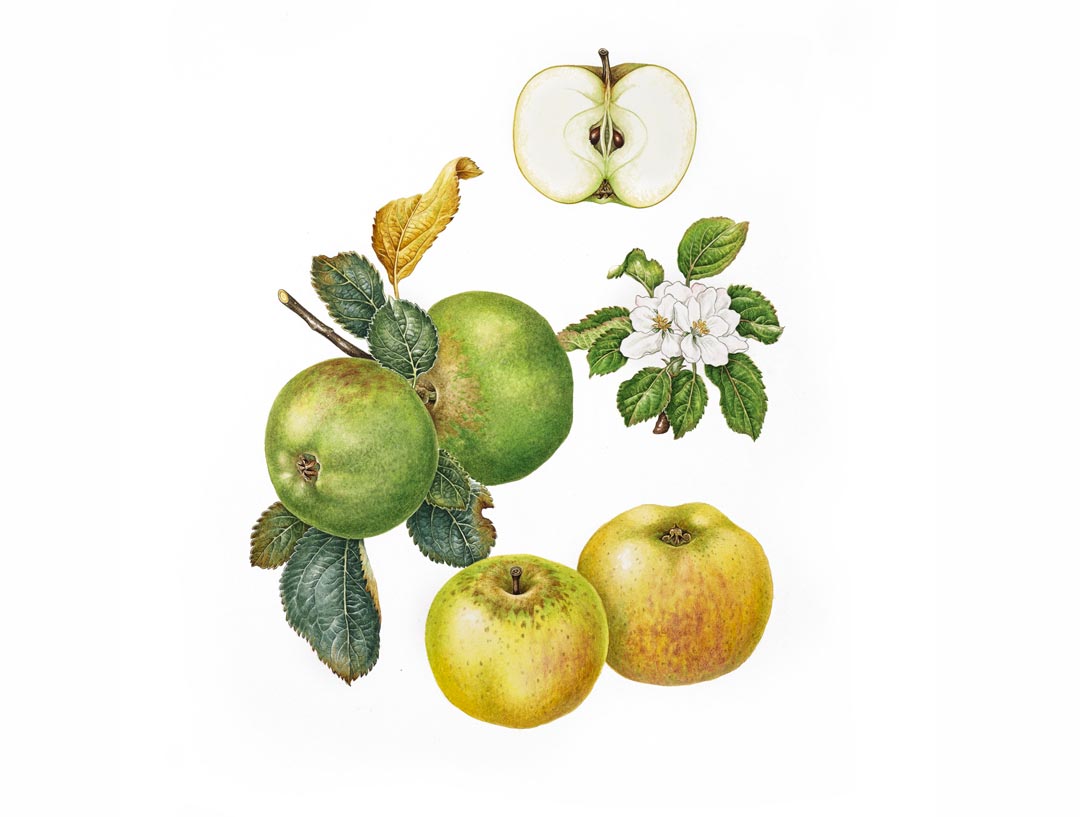

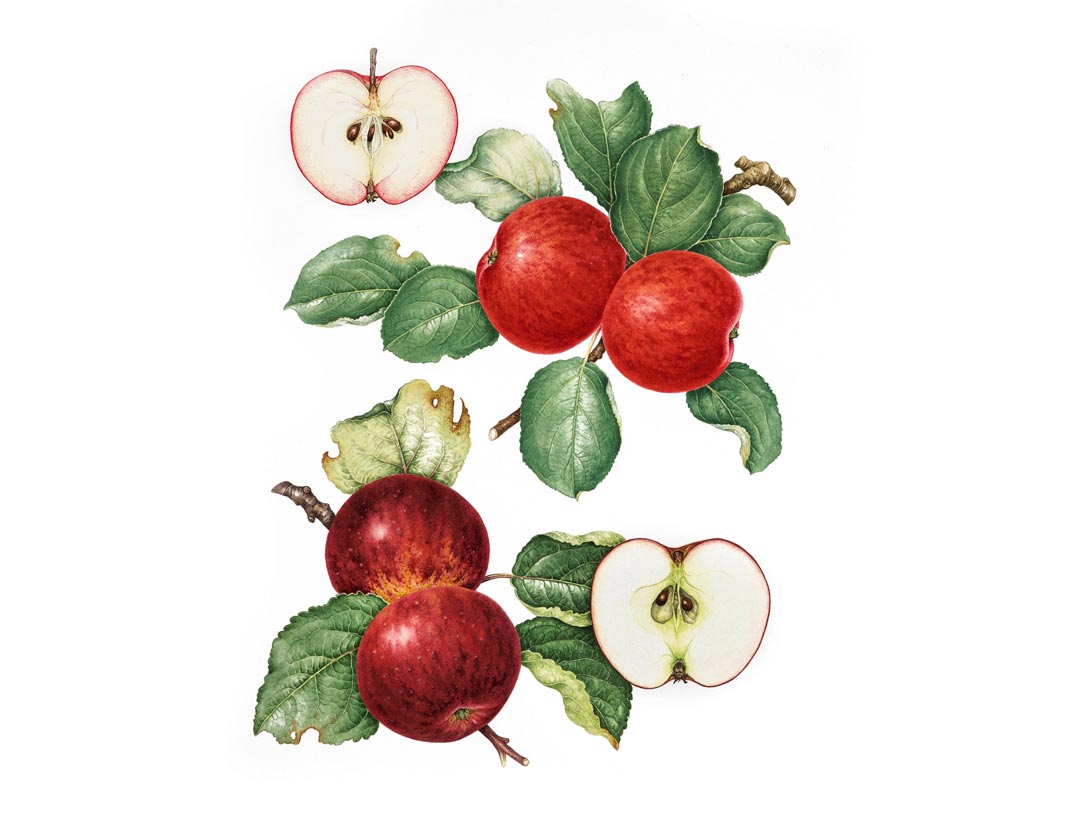
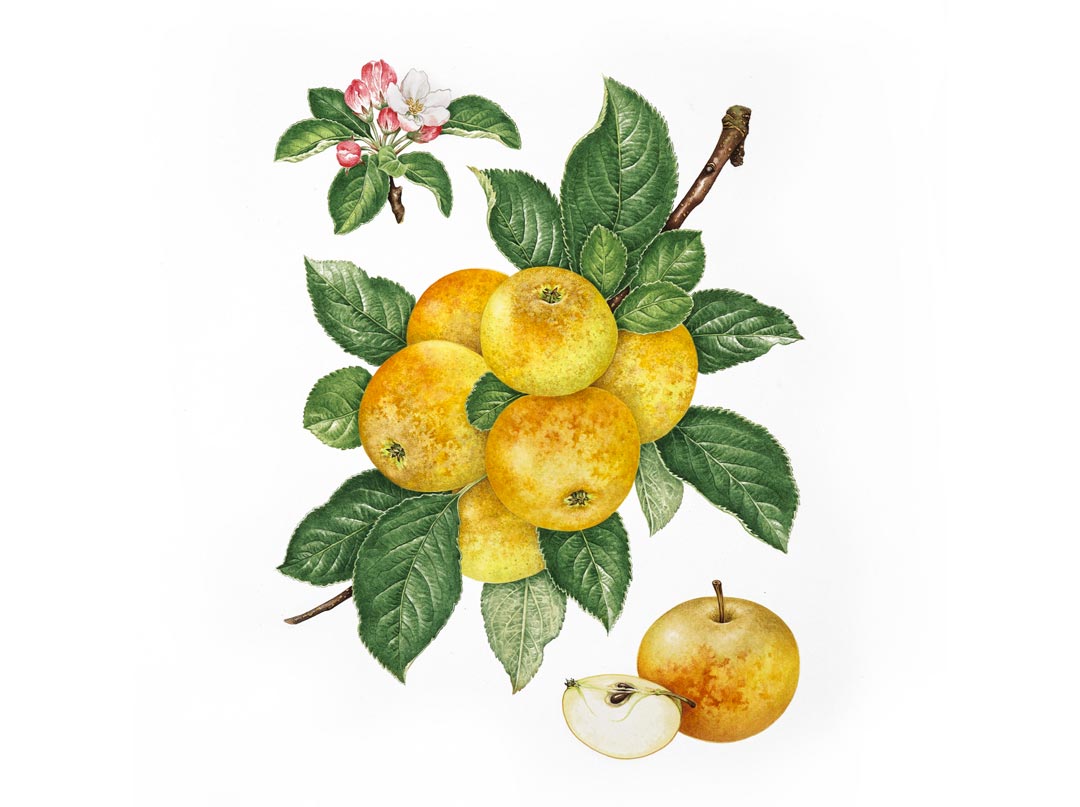
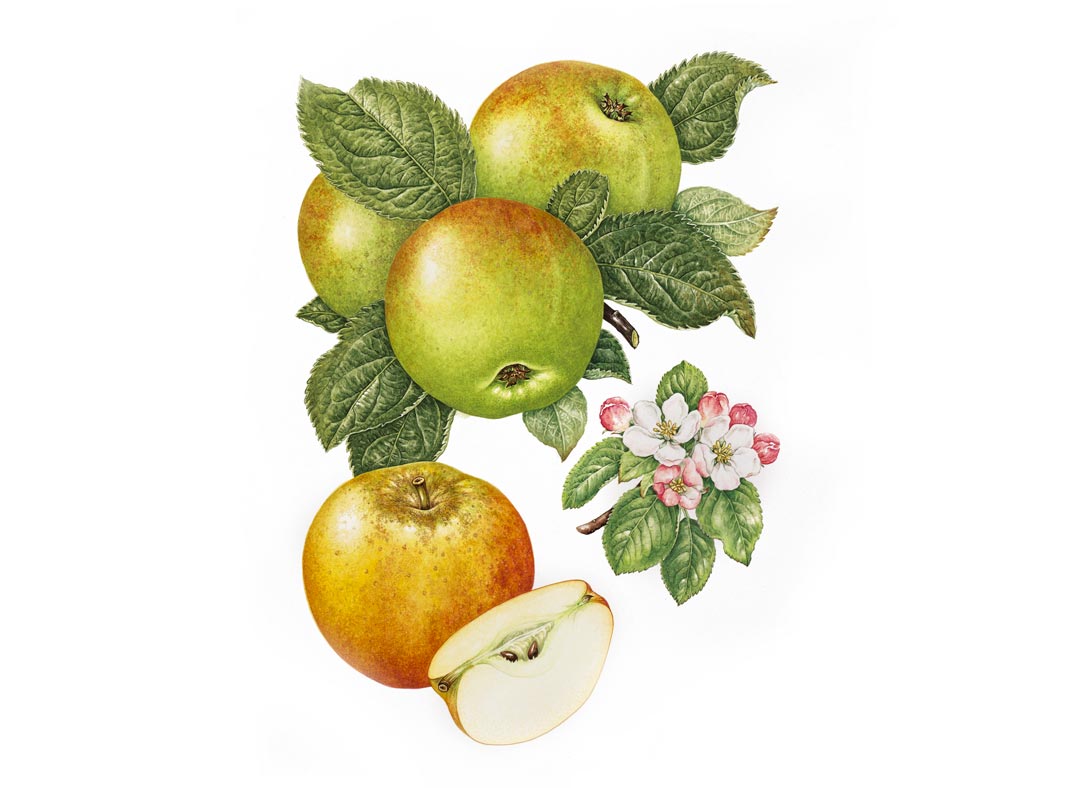
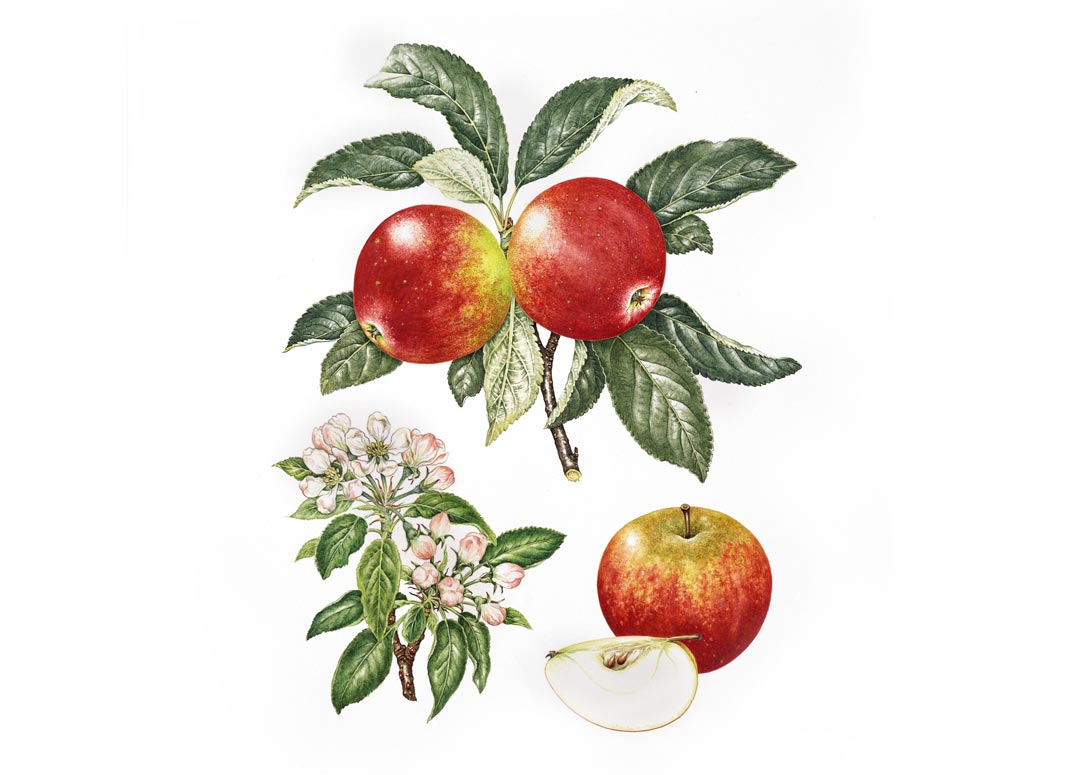


 William Arnold - 42 Wilding Apples of The Camborne & Redruth Mining District commissioned by Hereford Cider Museum Trust for Apples & People © the artist
William Arnold - 42 Wilding Apples of The Camborne & Redruth Mining District commissioned by Hereford Cider Museum Trust for Apples & People © the artist Inspired by Pissarro Spring Summer Autumn Winter
Inspired by Pissarro Spring Summer Autumn Winter